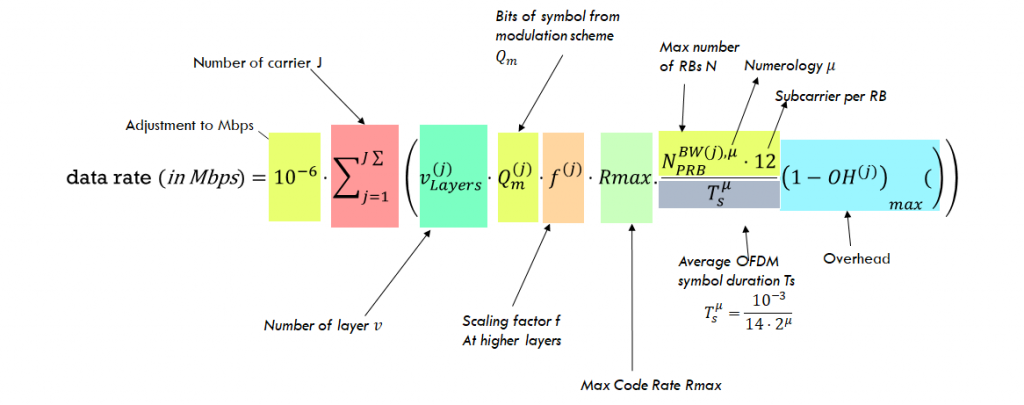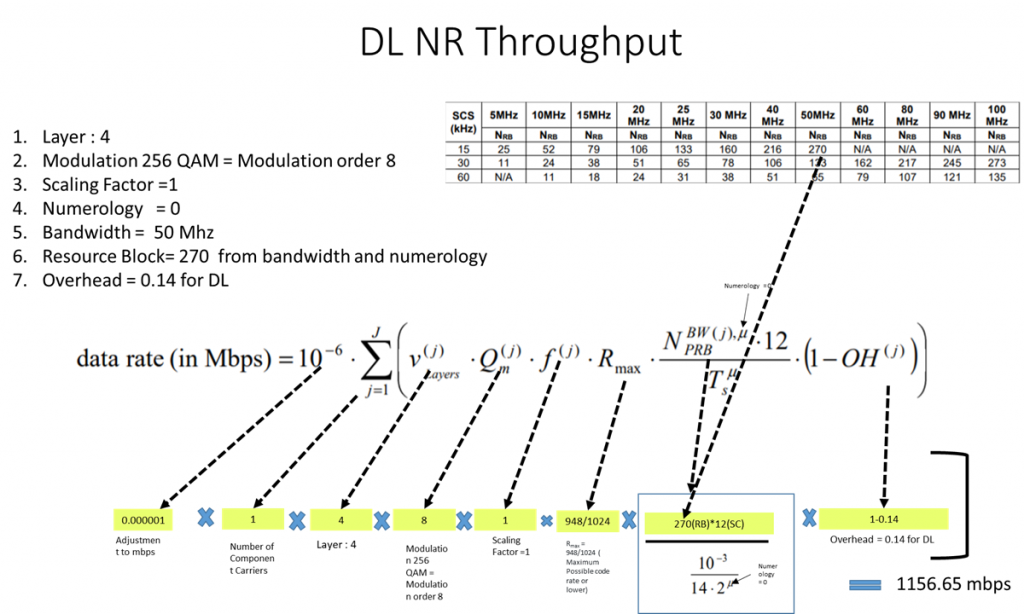
Date Rate Throughput defined in 3GPP 38.306(4.1.2)
The DL and UL max data rate supported by the UE is calculated by band or band combinations supported by the UE. A
UE supporting NR (NR SA, MR-DC) shall support the calculated DL and UL max data rate defined.
In NR Data rate calculated based on the resource allocation with the help of higher layer settings.
J is the number of aggregated component carriers in a band or band combination
Rmax = 948/1024 ( Maximum Possible code rate or lower)
v : Number of layers ( the maximum number of layer is 8), is the maximum number of supported layers given by higher layer parameter maxNumberMIMO-LayersPDSCH for downlink and maximum of higher layer parameters maxNumberMIMO-LayersCB-PUSCH and maxNumberMIMO-LayersNonCB-PUSCH for uplink.
Q: bits per modulation symbol, depending upon the modulation scheme, the maximum supported modulation order given by higher layer parameter supportedModulationOrderDL for downlink and higher layer parameter supportedModulationOrderUL for uplink
Q= 1 for BSPK , Q=2 for QPSK , Q=4 for 16 QAM, Q=6 64 QAM, Q= 8 for 256 QAM
f: is the scaling factor given by higher layer parameter (scalingFactor) and can take the values 1, 0.8, 0.75, and 0.4.
A first guess about the scaling factor is that it allows the adaptation of the UL-DL configuration in TDD with request to the Data rate, but the real motivation behind the scaling factor is based on the idea that it should be permissible for a UE to indicate a lower performance with respect to tha maximum peak data rate.
Nrb: is the maximum RB allocation in bandwidth with numerology, as defined in 5.3 TS 38.101-1 [2] and 5.3 TS 38.101-2 [3], where is the UE supported maximum bandwidth in the given band or band combination.

| BW(j) is UE supported maximum Bandwidth in a given band or in-band combinations. REs are grouped into PRBs (Physical Resource Blocks). Each PRB consists of 12 Subcarriers. |

Numerology is the numerology (as defined in TS 38.211)

Ts: Average OFDM symbol duration in a subframe for numerology. The normal cyclic prefix is assumed.
OH: This is the overhead and takes the following values
0.14, for frequency range FR1 for DL
0.18, for frequency range FR2 for DL
0.08, for frequency range FR1 for UL
0.10, for frequency range FR2 for UL
The approximate maximum data rate can be computed as the maximum of the approximate data rates computed using the above formula for each of the supported band or band combinations











